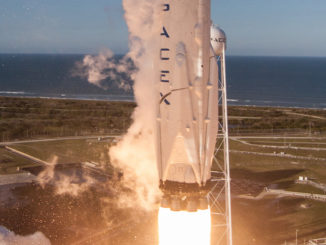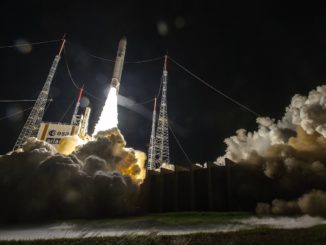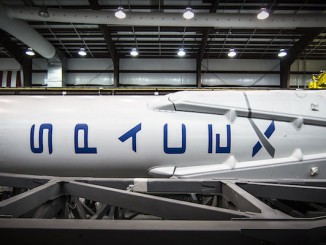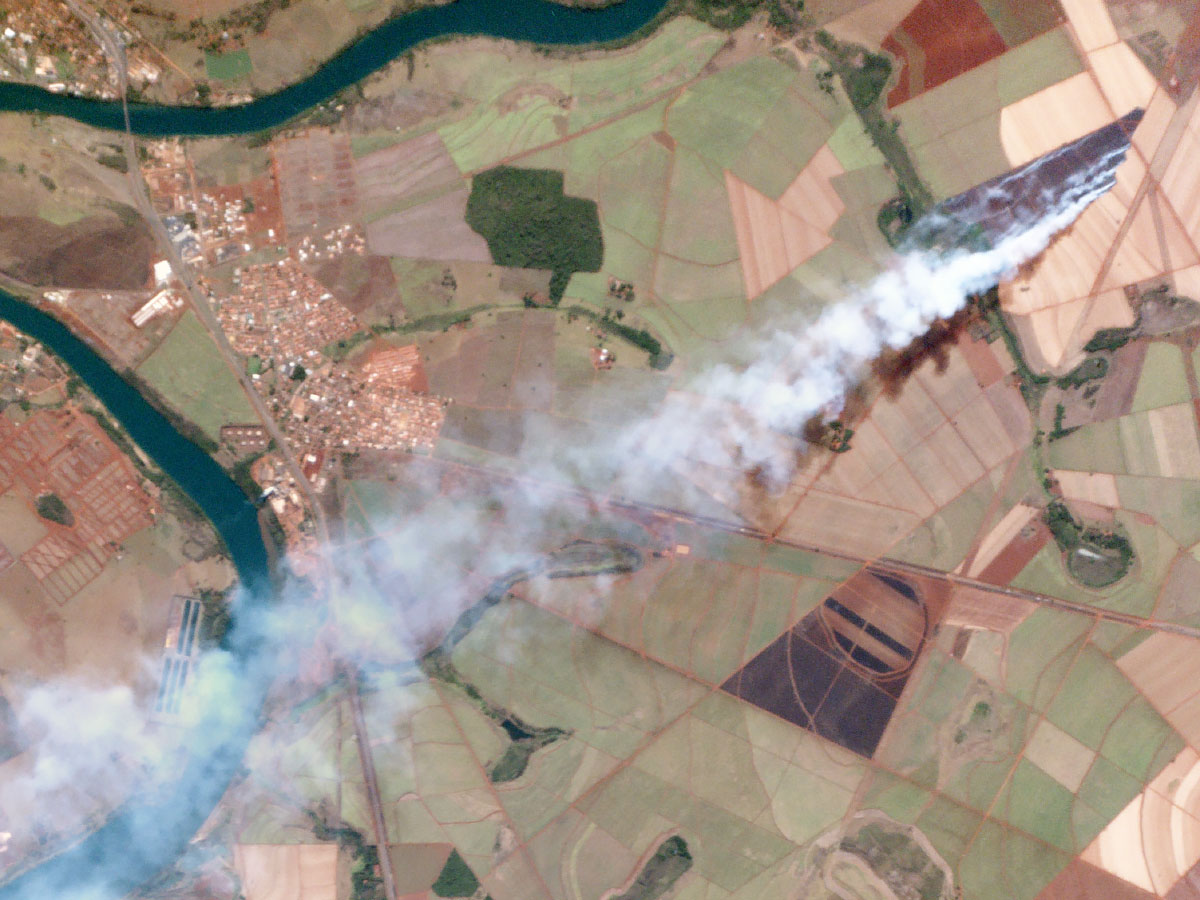
No one had ever lost 26 satellites at once until a launch failure bit Planet Labs last year, temporarily setting back the San Francisco startup’s ambition to map the globe every day.
Adding to the sting of last year’s Antares rocket crash in Virginia, Planet Labs lost another eight spacecraft aboard a failed launch of SpaceX’s Falcon 9 booster in June.
They were mass-casualty events, at least for the little robots Planet Labs is constructing and deploying around the planet to survey every part of Earth with unparalleled regularity.
With a fresh batch of shoebox-sized craft now safely aboard the International Space Station after launching Aug. 19 inside Japan’s HTV cargo craft, Planet Labs is ready to take a big step in recovering from losing two cadres of Earth observing satellites in the last year.
A display commemorating last October’s explosive Antares accident — complete with a haunting image of the Antares rocket immersed in a fireball — hangs in the lobby of Planet Labs headquarters in downtown San Francisco. Wreckage of the Planet Labs birds scoured from the Wallops Island beach near the Antares launch pad sits on a rack in a corner of the company’s workshop.
The group of 14 satellites launched by the HTV puts Planet Labs over the century mark. The successful delivery makes it 101 Planet Labs satellites successfully placed into orbit — some have already re-entered — and the latest group will be ejected this fall from pods mounted to the space station’s Japanese robotic arm.
Planet Labs’ satellites, called Doves by company insiders, go through design overhauls every few months. The craft are based on the CubeSat form factor, and engineers have figured out how to pack powerful new technologies inside the CubeSat’s compact dimensions.
With high-speed data links to beam back images to a network of ground stations around the globe, the satellites are now on their 12th generation. The newest set of Doves awaiting deployment from the International Space Station’s Japanese airlock carry upgraded cameras to snap sharper, more colorful photos of Earth.
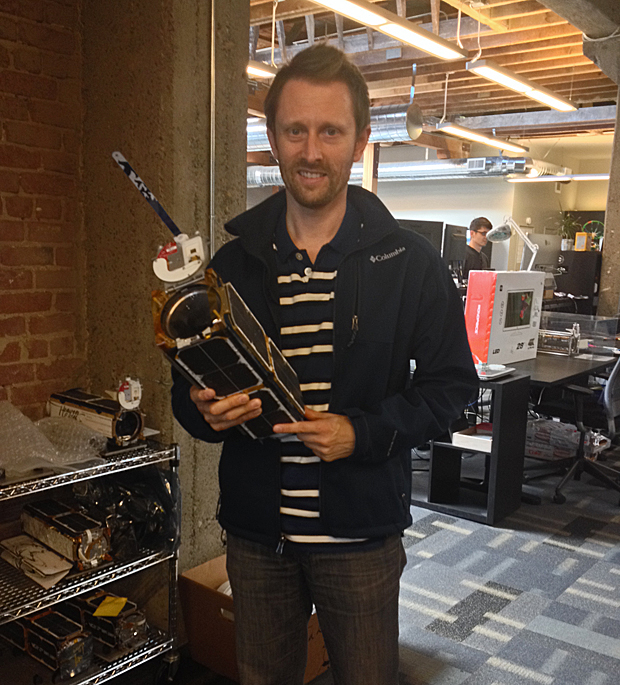
From the space station’s 250-mile-high orbit, the Earth-pointing telescopes on each Dove satellite can resolve objects on the ground as small as 2.4 meters, or 7.9 feet. Planet Labs plans to eventually deploy a larger fleet in sun-synchronous orbit, which is better positioned for imaging Earth under consistent lighting conditions.
Founded in 2010 and backed by Bay Area venture capital firms, Planet Labs set its goal to image the entire planet every day. The company says it needs more than 100 satellites for the task, and officials say they have not wavered after the launch failures.
“With a quarterly launch schedule across a network of international partners, and a highly talented and dedicated team, we will reach our goal of imaging the entire Earth, every day,” wrote Will Marshall, Planet Labs’ co-founder and chief executive, in the aftermath of SpaceX’s June 28 launch failure.
More Doves are manifested to blast off on the next SpaceX cargo launch to the space station and aboard Orbital ATK’s next Cygnus resupply freighter. Both missions are due for launch before the end of the year, adding to the several dozen Planet Labs birds currently in orbit.
The Dove deployments from the space station are arranged through NanoRacks, a Houston-based company set up to pursue the commercial exploitation of space.
Now with more than 100 employees, Planet Labs has raised $183 million in funding with the end of its Series C round of financing in April, according to TechCrunch. The company announced in July its acquisition of BlackBridge, which runs the five-satellite RapidEye constellation, adding more imaging capacity and a data catalog to Planet Labs’ pipeline.
Spaceflight Now recently visited with Chris Boshuizen, Planet Labs’ co-founder and chief technology officer, at the company’s headquarters in San Francisco. Boshuizen discussed the Planet Labs manufacturing philosophy, the company’s response to the Antares crash and the dynamics of the small satellite market.
Excerpts from the interview are posted below.
Q: You have launched a lot of satellites over the last couple of years. How does your process differ from the way more traditional operators work?
A: “We do a cycle about once every three months — about eight to 14 weeks on average. Why do we do this? A traditional NASA mission uses a systems engineering philosophy I call BDUP — Big Design Up Front — so you spend some amount of time, between two years and 20 years, whether it be something like LADEE or something like James Webb (Space Telescope), doing design, and then finally you have a PDR and CDR (preliminary design review and critical design review), you get green-lighted, and you finally get to start building stuff. The last part for most missions is pretty quick, the manufacturing and AIT (assembly integration and test) happens pretty quickly, and you’ve never really touched the hardware until the very end of the cycle.”
“Many, many years, in some cases, has gone by with many of the risks pushed to the back, and to buy that risk down, people keep re-designing. So they go, ‘I think the structure is a bit light, maybe we’ll change these software modes, or we need to add solar power.’ It’s this endless cycle, which is part of what drives the much higher costs of these missions. You have no idea what your risks are, so you just try and answer them all. What we did is instead of having a set of requirements designing the satellite and then launching once, we said, ‘Let’s try and evolve to it, and try to understand what our real requirements are, and which things are required and what doesn’t really matter.'”
“Instead of having requirements, we had a reference design, and the reference design was to have satellites that could image the whole Earth every day — all land areas — and download that within one day with one-day latency. The field-of-view would be big enough that with a reasonable number of satellites, we could cover the whole world.”
“We try and run the company a little bit like a software company, so I call all of those things features. The goal is to release sequential products that release more of those features until you have a feature-complete design and we’re actually operating a feature-complete satellite.”
Q: What sort of upgrades have you added to the missions since the first one in 2013?
A: “Dove 2, which was actually our first satellite, was Generation 4. That was about 30 percent feature complete. It didn’t have reaction wheels, and could only point at the Earth when the magnetic field was pointing at the Earth because we were field-stabilized.”
“Dove 1, which launched a couple days later, was Generation 6, and that added some new features like a high-speed radio so we could get more than one image per day. It had flip-out solar panels so we could get more power, and reaction wheels so we could point. Those three things were added between Generations 5 and 6.”
“Generation 10 was what was sort of really our first stable bus, where we’d now refined the radio, we had the CONOPS pretty much nailed and understood, how the electrical system was working, the control systems, the sensors worked. Generation 10 is about 90 percent feature complete, I would say. There are just a couple of small details now, like star cameras and GPS, that need to be refined. We’re doing prototypes for those now.”
“Generation 12 is our first feature upgrade, so we’re adding a better camera. The camera was the first thing we settled on with Generation 1. Generation 12 has us going back to the beginning, and saying, ‘Cool, now we’ve got to the end of the road. What are our next enhancements?’ So we’re looking at an improved camera with better image quality.”

Q: What is better about the camera?
A: “It’s essentially the same resolution. It’s just overall sharper, better contrast, better sharpness, better separation of pixels, better color bands, just overall nicer and crisper images.”
Q: What is your ground station network like?
A: “We have about 10 ground stations around the world in X-band, each with 4.5 to 5-meter dishes. Typically, we get, on an average pass, somewhere around 2 gigabytes per pass. That’s one spacecraft per pass. Just for framing, our radio speed is right now about 40 megabits a second, which is pretty phenomenal for a CubeSat. Up until about 2013, I think the mission lifetime record for a CubeSat, for data down, was 2 gigabytes in a mission lifetime. We’re now doing 2 gigabytes per pass. I think that spacecraft was RAX-2, one of the spacecraft from the University of Michigan. That was a pretty good satellite by CubeSat standards.”
“Our record to date has been 3.5 gigabytes in a single pass. I was at a CubeSat conference in 2013, and people were saying they thought X-band radio in a CubeSat was impossible, and I already had one in orbit. They didn’t know.”
Q: How many spacecraft do you need?
A: “For the business, not that many. We already have a really thriving business. We’ve got more in signed contracts now than we’ve raised in VC money. The business is extremely healthy. We’re shipping data to the customers, and feedback from the customers has been extraordinary. They’re able to do things they’ve never been able to do before because of our broad coverage and frequent updates.”
“For our mission, we want to image the whole world every day, and that does have a minimum number of satellites. We think the minimum for that is somewhere around 100 to 125. The exact number changes if you want to add in redundancy, orbital spares, and things like that. We want them to eventually go into one orbital plane in sun-synchronous orbit. It sort of creates a line scanner for the world.”
“With the current business, that constellation will provide a game-changing capability, where you can do day-to-day change detection, and discover things that you don’t know about. The serendipitous discovery of events, even finding like a landslide in a remote area that no one knew about, that’s the kind of thing I think we can do when we have daily updates. That’s extraordinarily valuable for business. For humanitarian and environmental applications, I think it has incalculable value. It’s huge.
“We’re partnering with non-profits, organizations interested in environment, climate change, deforestation, food security, land ownership and protection of indigenous land rights. One of the things that we’re obligated to do as part of our imaging license is to distribute data in times of need and disaster. We distributed data to relief agencies under a creative commons license after the Nepal earthquake (in April), and found towns needed aid near Kathmandu. That’s the first really big real-time response we’ve been able to help with, and I’m very proud of the fact that we were able to help there.”
Q: It seems like there is no shortage of announcements for new small satellite constellations. Is there any concern about this trend generating more space debris?
A: “I think that’s become possible. The community’s comfort with that has been growing, I think. We obviously need to set very firm codes of conduct to ensure that the commons of space is respected, and everyone is a responsible actor. Here at Planet Labs, we realize that being the first to do this, we have to set the best example of what best practices are, and we don’t want to be the company to mess it up for everybody.”
“We have very strict debris mitigation policies. Our principle response to that is to launch into very low orbits that self-clean, which is why we use the ISS for a lot of our demonstrations. One of the big aspects is community sharing of information, so its going to be really key that everybody has up-to-date and accurate orbital information on their assets.”
“We publish our own satellite ephemeris back to JSPOC (the U.S. military’s Joint Space Operations Center) and Space Track, and make that freely available to anybody else to track our satellites and do their own conjunction analyses with their own assets. I think this free sharing of information is important, creating the culture that it is OK to share, and that the needs of the community to know where everything is outweigh the needs for privacy.”
Q: How big are your satellites, and why did you pick that size?
A: They’re about the size of a bottle of wine, or a loaf of bread, or a small cat. Around 5 kilograms (11 pounds). I call them enhanced CubeSats because we broke most of the specification, but we still fit in a more or less standard dispenser, just with a few modifications to fit the camera and stuff. We’re right at the limit of the spec in most regards.”
Q: Do you see Planet Labs growing beyond the CubeSat form factor in the future?
A: “Not really. I think one of the fun things about our iteration approach is every time we’ve added a new feature, we have a little bit of empty space, and we put some new component in there like the reaction wheels, then in the next generation we re-factor the design and improve its manufacturability. Then magically I get the space back again. Generation 10 has as many free cavities in it as Generation 1 did. There’s still as much free space, and I can still put more stuff in. Generation 12, somehow, is about double the free space as Generation 10 because we did a nice job repackaging things. We’re very far from the end of the road, from what I think we can do with a CubeSat.”
“When people talk about launch, they often talk about cost per kilogram, they’re like we really need to get price per kilogram down. But my view is you don’t want to launch dumb mass. You want to launch smart mass, so you actually want to increase your capability per unit mass, and then launch cost doesn’t matter. You end up with capability per unit launched, and not mass because dumb mass has still got mass.”
“At the end of the day, I think the Planet Labs satellites might be 5 kilograms of really dense computation capacity, batteries, power and software. The more you can put in a box, the more you can do, so I think we have a long way to go.”
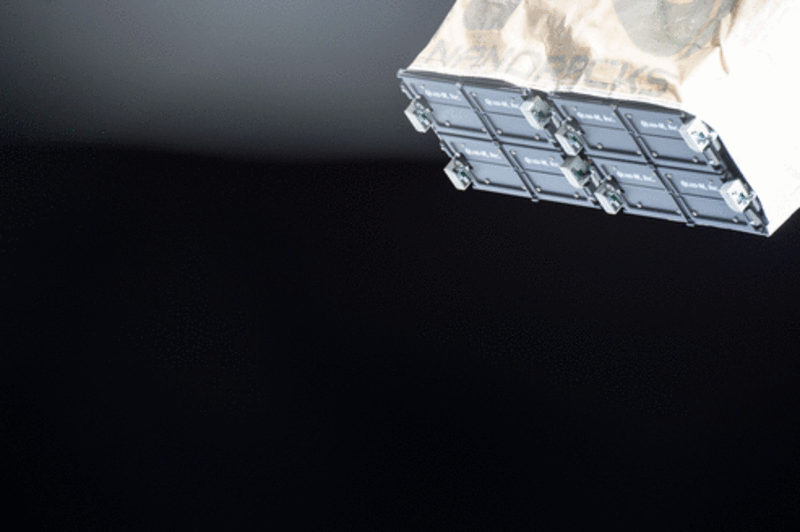
Q: Your plans call for an operational fleet in sun-synchronous orbit, so is there future use of ISS by Planet Labs?
A: “I think the ISS is awesome for gap-filling and capability extension, and we will continue to iterate and to fill that box with everything we can possibly fill it with. We’re still going to need regular access to space. I think we’ll just launch smaller fleets to test out new ideas from the ISS. If we get it wrong, the satellites will just burn up and clean themselves up.”
Q: How are sun-synchronous satellites at higher altitudes compliant with the standard 25-year de-orbit guidelines?
A: “Ideally, we want to launch our operational fleet into a very low sun-synchronous orbit, around 450-500 kilometers (280-310 miles). At 650 kilometers (404 miles), you’re compliant with the 25 to 30-year de-orbit rule. From 700 kilometers (435 miles) and up, you’re not compliant anymore, so we certainly would never launch any higher than 700. But 650, for us, is still too long. You’re still talking upwards of 20 years at 650. At 500, you’re more like four to seven years, so that’s our way of playing it very safe. Of course, resolution is linearly proportional with altitude, so the images are 30 percent sharper at 500 than 650 kilometers.”
Q: What is your resolution from the altitude of ISS?
A: “At ISS altitude, the ground sampling distance is something like 2.4 meters (7.9 feet). That’s from a CubeSat, mind you, and it’s slightly less — around 3 meters (9.8 feet), from a sun-synchronous orbit.”
Q: What was the mood here when you lost 26 satellites on Antares?
A: “I think people handled it pretty well. We have this great photo of the crowd gasping in shock with the explosion reflected off the window behind them. I think, at the time, people took it pretty well. No one was really upset. I think, in some sense it was a vindication or validation of our approach, which is that we have redundancy and safety in numbers. We have other satellites, and we still have continuity, and we still have launches. So I’d say overall the business has not suffered, but our fleet size is smaller than we would want right now. We have to be more careful with the satellites we’ve got, and if we have issues, we can’t just switch to spares, so we’ve definitely been pinched operationally, and had to pay a lot more attention to the satellites we have. I didn’t appreciate that back then at the time of the explosion — that there would probably be some type of cost to us down the road.”
Q: Did NanoRacks give you a free re-launch?
A: “I don’t know about free, but they were pretty damn good about hustling and getting things ready in time. This is how extraordinary they were. We built two satellites in nine days in response to the explosion to carry critical new tech demos of new features I wanted to test. I think we had four experimental satellites on the Antares that were destroyed, so I re-built those tech demo satellites, combined the tech demos down to just two satellites, and shipped them to NanoRacks in nine days. They were able to get them on SpaceX-5 (a resupply mission in January 2015), and out the hatch in about 30 days. They were super responsive, and those satellites are in orbit now, and we’ve got a lot of good tech demo data from them.”
Q: Were the satellites insured?
A: “No, we didn’t insure those. Our entire business model is self-insured. If you look at current space insurance premiums, they’re like something between 10 and 12 percent, so you’re assuming one in 10 launches fails, at a minimum.”
Q: With launch delays being part of the space business, how do you keep up the production cadence?
A: “We make satellites here on site in San Francisco. We used to make satellites for launches, but that meant there were crunches, and it was all hands on deck to make the shipment deadline. Now, we just make them with a steady state production line, and we pump out about five per week.”
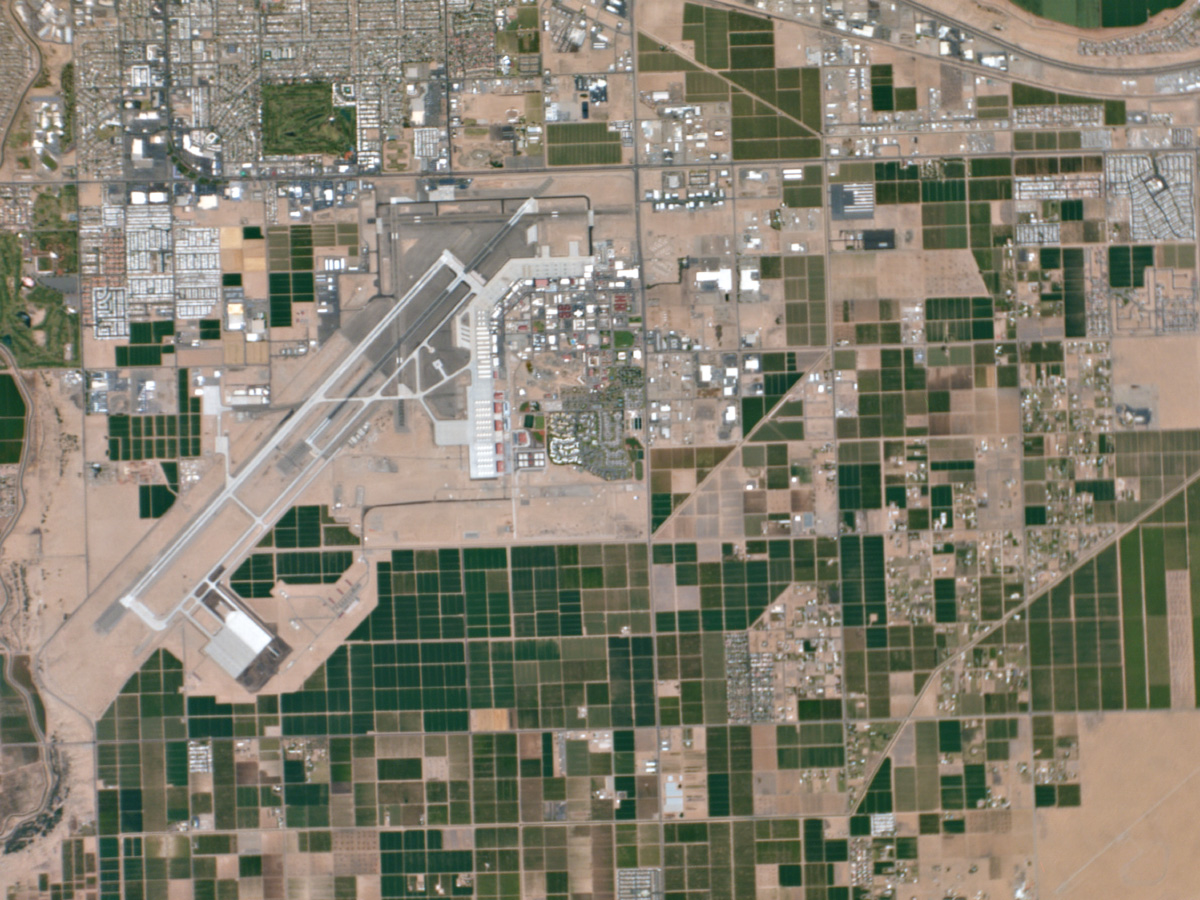
Q: What are your thoughts on dedicated launchers for nanosatellites? Does a business like Planet Labs need that?
A: “I think it’s super useful.”
Q: Useful or required?
A: “I would say required, but perhaps not in the way people expect. For us, the most useful thing is quick turnaround time for testing new ideas. Even with the space station, it can be a bit slow. Even if we build satellites quickly, and NanoRacks get them manifested just in time to make the late-load stocking the Dragon or the Cygnus capsule, once you get to station, you’re still waiting for an opportunity for an airlock cycle. That can take anywhere from a month to three months.”
“If I could build a new satellite, launch it this weekend, get it into orbit, get the results, and come back and re-iterate the design, that could be game-changing. So I think, irrespective of price, that would be hugely valuable to us. You obviously don’t want to pay 10 times the price, but I think there’s a common misconception that nanolaunch also has to be cheaper per kilogram. I don’t know how those two things got conflated. I think that’s a mistake. If it was the same price, but happened regularly, that’s a win.”
“The other dimension is, for operational constellations, the answer is opposite. I want some sort of bulk discount. If there was a company that could do regular high-volume launches — 100 satellites a month or something — and just keep doing it forever, then I would use that, too. But it would have to use commodity pricing. I would take either of those, actually.”
Q: What price for a dedicated launcher makes sense?
A: “It depends. CubeSats range, for a 3U (three-unit), anywhere between $200,000 to $450,000 across all families of rockets. Those are the prices I’ve seen throughout my career. The misconception is that nanolaunch also has to change the price per launch equation. I don’t believe thats true. It’s not like nanolaunch has to come in at $100,000 or $50,000 per satellite. Even if they were still in the $200,000 to $400,000 range, but they were responsive, that would be a fair market price for a quick turnaround launcher.”
“Nobody’s done it yet, so we don’t actually know what their payload fraction is going to be. If they end up with, say, 50 kilograms (110 pounds), that’s pretty respectable. Counting dispensers, that’s about five satellites. That would be an entire cadre of tech demos I could launch in one go. At that point, I’d get a lot of value learning about how those satellites did. If I was launching one, if I wanted to learn something really important to feed into a future sun-synchronous launch, I’d pay the same price. It would be worth it for me to do it — to launch one satellite to get information I needed to buy down risk for a future launch. Anywhere in the $200,000 to $400,000 range would be fair for a one-off launch.”
Q: What’s next for Planet Labs?
A: “Just shipping product to customers, making customers happy, and then growing our capacity to get towards daily coverage. That’s where we’re at right now.”
Email the author.
Follow Stephen Clark on Twitter: @StephenClark1.

